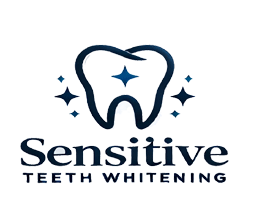If you have tooth pain when your teeth feel cold or hot, you may want a whiter smile. Many people face this challenge. Normal whitening methods can hurt your teeth. Sensitive teeth whitening strips use a lighter gel. They help you get a bright smile while caring for your teeth.
In this article, we explain how these strips work. We list their good points and help you pick a safe product.
Understanding Tooth Pain and Whitening Problems
Tooth pain comes when your enamel wears thin or your gums fall back. This change leaves the inner tooth exposed. It may hurt when you eat or drink things that are hot, cold, or sweet. Many whitening methods use strong peroxides. These chemicals can make the pain worse by affecting the nerves.
For many with tooth pain, using a gentle method is key. This is where whitening strips for sensitive teeth work well. They use less peroxide. Some even use extra ingredients that ease the pain.
What Are Whitening Strips for Sensitive Teeth?
Whitening strips for sensitive teeth use a thin plastic that fits on your front teeth. The strips carry a soft bleaching gel. The gel works slowly on your teeth. This careful action helps to avoid pain.
Key Features:
- Lower peroxide levels: Usually 3-6% against higher strengths in other strips.
- Pain-easing ingredients: They use substances like potassium nitrate or fluoride to calm nerves.
- A flexible fit: The strips stick well to your teeth and miss the gums.
- Short use times: They work fast without long contact on your teeth.
Today, many brands sell these gentle strips. They help those with tooth pain get a bright smile with less pain.
Benefits of Sensitive Teeth Whitening Strips
Using these strips has many good points:
- Less pain: The soft formula helps keep teeth and gums calm.
- Ease of use: You can apply them at home. No messy trays or dentist visits are needed.
- Slow and steady change: They make small changes that add up.
- A low cost: They cost less than many dentist treatments.
- A plan that fits you: You can set the time and days to match how your teeth feel.
How to Use Whitening Strips Safely and Well
Follow these steps to get the best results and care for your teeth:
- Ask your dentist first: They can tell if your tooth pain comes from another problem.
- Read the guide: Each strip type has its own rules on how long and when to use.
- Clean your teeth: Brush and floss well before you stick on the strips. Do not use rough toothpaste.
- Fit the strips: Place them well on your teeth. Avoid touching your gums.
- Rinse your mouth: Use warm water after you take off the strips.
- Pick a soft toothpaste: A toothpaste for sensitive teeth will ease any pain.
Stick with the method for many days. You may see a brighter smile after a week or two.
Top Ingredients in Sensitive Teeth Whitening Strips
When you shop for these strips, check for these good ingredients:
- Potassium Nitrate: It calms the nerve endings in your teeth.
- Fluoride: It makes the enamel strong and helps calm pain.
- Lower levels of peroxide: They make whitening soft.
- Aloe or Chamomile: These help calm your gums and tissues.
A right mix of these ingredients gives you both safe whitening and care.
Popular Sensitive Teeth Whitening Strip Brands
Here are some brands that many people like:
- Crest 3D White Whitestrips Gentle Routine – Made with low peroxide for sensitive teeth.
- AuraGlow Sensitive Teeth Whitening Strips – Has aloe and a soft formula.
- Rembrandt Gentle Whitening Strips – Uses potassium nitrate for care.
- Supersmile Professional Whitening Strips – Contains fluoride and is known by dentists.
Tips to Keep a Bright Smile After Whitening
After you use the whitening strips, try these ideas:
- Stay away from foods and drinks that stain, like coffee, tea, red wine, and berries.
- Brush your teeth twice a day and floss every day.
- Drink colored drinks with a straw to protect your teeth.
- Visit your dentist for cleanings to remove any new stains.
- Use touch-up strips as needed to keep the shine.
Frequently Asked Questions (FAQ)
Q1: Can these strips reduce pain while they whiten?
A1: Yes. They are made with a soft gel and nerve-calming ingredients.
Q2: How many days do I use the strips for a change?
A2: Many see a white smile in 7 to 14 days. Each mouth is different.
Q3: Can I use the strips every day?
A3: They are safe when used as told on the label. Do not use them too much. Ask your dentist if you have concerns.
Expert Opinion on Sensitive Teeth Whitening
The American Dental Association notes that products with their Seal of Acceptance are safe when used right. Picking a strip made for sensitive teeth protects your mouth and still gives you a white smile.

Conclusion: Brighten Your Smile With Less Pain
Your tooth pain need not stop you. Whitening strips for sensitive teeth let you gain a bright smile without more pain. When you choose the right product and follow the steps, you can see a change at home.
Ready to try a low-pain way to get a whiter smile? Look for trusted sensitive teeth whitening strips today. Enjoy a brighter smile and feel good about your teeth.




